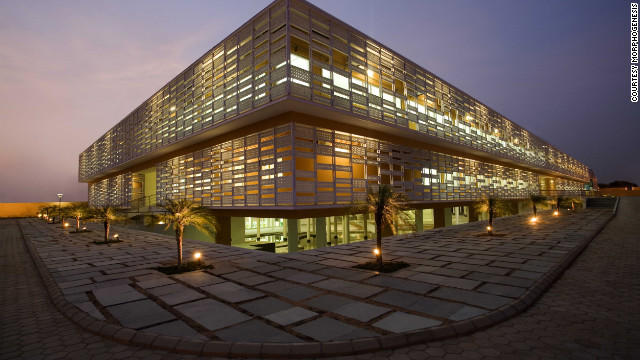Welcome to DU!
The truly grassroots left-of-center political community where regular people, not algorithms, drive the discussions and set the standards.
Join the community:
Create a free account
Support DU (and get rid of ads!):
Become a Star Member
Latest Breaking News
General Discussion
The DU Lounge
All Forums
Issue Forums
Culture Forums
Alliance Forums
Region Forums
Support Forums
Help & Search
Environment & Energy
Related: About this forumAncient 'air-conditioning' cools building sustainably
http://edition.cnn.com/2012/02/28/world/asia/ancient-air-conditioning-architecture/index.html?hpt=wo_bn1
Built in the arid suburbs of Jaipur, Rajasthan, The Pearl Academy of Fashion combines modern exterior styling with ancient Rajasthani architecture -- designed to keep temperatures down without artificial cooling systems.
aipur, India (CNN) -- How did buildings keep cool before the invention of air conditioning? As architects consider how to reduce the energy demands of new builds, some are turning to the past for simple, low-tech solutions.
At the height of summer, in the sweltering industrial suburbs of Jaipur, Rajasthan in north-west India, the Pearl Academy of Fashion remains 20 degrees cooler inside than out -- by drawing on Rajasthan's ancient architecture.
While the exterior appears very much in keeping with the trends of contemporary design, at the base of the building is a vast pool of water -- a cooling concept taken directly from the stepwell structures developed locally over 1,500 years ago to provide refuge from the desert heat.
Award-winning architect Manit Rastogi, who designed the academy, explains that baoli -- the Hindi word for stepwell -- are bodies of water encased by a descending set of steps.
Green lessons from Mughal architecture
"When water evaporates in heat, it immediately brings down the temperature of the space around it," he says.
While traditional stepwells often go many stories below ground level, Rastogi's go down just four meters. However, the effect is the same and -- like the ancient Mughal palaces before it -- the academy enjoys its own microclimate.
InfoView thread info, including edit history
TrashPut this thread in your Trash Can (My DU » Trash Can)
BookmarkAdd this thread to your Bookmarks (My DU » Bookmarks)
9 replies, 4769 views
ShareGet links to this post and/or share on social media
AlertAlert this post for a rule violation
PowersThere are no powers you can use on this post
EditCannot edit other people's posts
ReplyReply to this post
EditCannot edit other people's posts
Rec (65)
ReplyReply to this post
9 replies
 = new reply since forum marked as read
Highlight:
NoneDon't highlight anything
5 newestHighlight 5 most recent replies
= new reply since forum marked as read
Highlight:
NoneDon't highlight anything
5 newestHighlight 5 most recent replies
Ancient 'air-conditioning' cools building sustainably (Original Post)
xchrom
Mar 2012
OP
Actually, if it's dry outside, the cooling should be much more effective than that.
SolutionisSolidarity
Mar 2012
#8
NEOhiodemocrat
(912 posts)1. Very interesting article
Thanks for posting
peacebird
(14,195 posts)2. Fascinating! Great article, Thank You!
cachukis
(2,277 posts)3. Very Cool
aquart
(69,014 posts)4. Humans! The things they think of!
annabanana
(52,791 posts)5. Kicking for History lessons!. . .n/t
MADem
(135,425 posts)6. The video at your link is marvellous. nt
NewJeffCT
(56,829 posts)7. so, when it's a dry 110 degrees outside
it's a humid 90 in the building?
SolutionisSolidarity
(606 posts)8. Actually, if it's dry outside, the cooling should be much more effective than that.
The wet bulb temperature at 110 F and 0% humidity is 53.7 F. At 30% humidity it is 75.7 F, and by 70% it's 102.8 F. An evaporative cooling system like this would work very well in a dry climate. And there are ways to get around the humidity issue. Through the use of heat exchange systems, there's no real reason why the air in the cooling system need ever come into contact with the indoor air. And air conditioning can provide supplemental cooling while drying out the air, as well.
NickB79
(19,274 posts)9. How much water would a system like this require?
I'm thinking how something like this would be applied to the US Southwest, and am a bit concerned where exactly they would get all that extra water from in such an arid region.